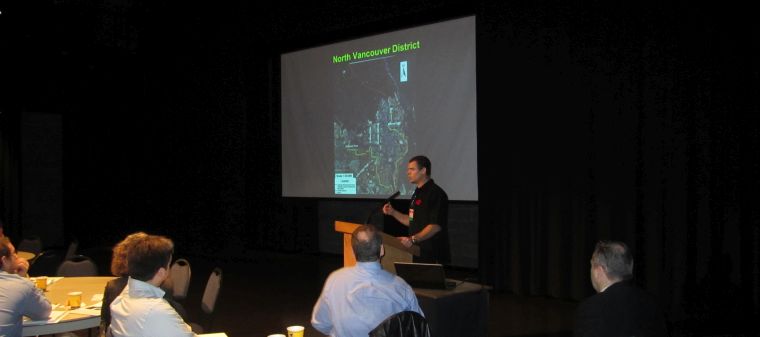Water Stewardship in a Changing Climate: Richard Boase brings an inter-regional perspective to his moderator role at the Nanaimo Water Symposium (April 12, 2018)

Richard Boase using marbles to demonstrate impact of impervious area on rainwater runoff at pilot WBM training workshop for partner local governments in 2003
Announcement: Richard Boase of North Vancouver will moderate the Nanaimo Water Symposium
The Nanaimo Water Symposium Organizing Committee is excited to announce that Richard Boase is the Symposium Moderator.
 Teaching, researching and working with bright, innovative people has resulted in collaborative efforts involving numerous post-graduate research projects investigating a wide variety of topics, including heavy metal contamination and mitigation in urban runoff to hydrological quantification of urban tree canopies.
Teaching, researching and working with bright, innovative people has resulted in collaborative efforts involving numerous post-graduate research projects investigating a wide variety of topics, including heavy metal contamination and mitigation in urban runoff to hydrological quantification of urban tree canopies.
He is currently Vice President of the Partnership for Water Sustainability in BC. This provides an outlet for his passion involving water resources, allowing him to share his experience through the Georgia Basin Inter-Regional Educational Initiative (IREI).
To Learn More:
For more background on Richard Boase, click on A crucially important message in Beyond the Guidebook 2010: “We now have the tools and experience to design with nature”

Georgia Basin Inter-Regional Educational Initiative
The Partnership for Water Sustainability is currently delivering an outreach and professional development program branded as Sustainable Watershed Systems through Asset Management.
Over the past decade, Richard Boase has been a key member of the Partnership team for training workshops and “sharing and learning” sessions in Metro Vancouver, Capital Region, Cowichan Valley, Comox Valley and Nanaimo Region.
Richard Boase has played a leadership role in the development of the Water Balance Express for Landowners, an interactive online tool. “It allows users to click and drag components,” says Richard. “They learn what it means and how to slow, spread and sink rainwater that runs off hard surfaces.”
Under Richard’s leadership, the District of North Vancouver was the demonstration application for development of the original Beta version of the Express. The District is currently partnering with the Province and the Partnership to furtherv evolve the capabilities of the Express.
“An emerging realization is that our work and online technology now provides another opportunity to drive the kind of change we need and want,” states Richard Boase. “We have developed a technology that is simple, easy to use, science-based and is highly educational. More importantly use of the Water Balance Express is intended to direct a behavioural change in the type of things people do with their land. We want people to make decisions on their properties that positively affect watershed health.”

Richard Boase doing a soil-water demonstration in 2004 at a Water Balance Model Training Workshop hosted by BCIT and sponsored by UDI.

Richard Boase in action at the 2008 Water Balance Forum hosted by the Cowichan Valley Regional District

Richard Boase at a “sharing & learning” session hosted by the Comox Valley Regional District(April 2013)

Richard Boase in action during the “Course on the ISMP Course Correction”, co-hosted by the Partnership and City of Surrey, Nov 2011
Why the Water Balance Model Express for Landowners
Homeowners can locate their property on a map, recreate their current house and yard, and then like Lego, add building blocks of different rainwater management features to the property, to reduce their property’s runoff and infiltrate more water into the soil.
A tutorial video is helpful in demonstrating how the addition of the ‘Lego blocks’ can improve the stream health score.
The Water Balance Express for Landowners was created to spur changes in practice. Although it may be viewed by some as an educational tool, use of the Express would help local governments achieve a regulatory outcome that is framed this way: implement performance targets, restore stream health.
The Express is integrated with Google Maps / Earth and land use zoning. Also, the Express has pre-set, region-specific Water Balance performance targets for volume, infiltration and flow. An image of a gauge provides a visual measure of stream health.
Tool development was co-funded by the governments of Canada and British Columbia, the Metro Vancouver Regional District and others under a climate adaptation program.


